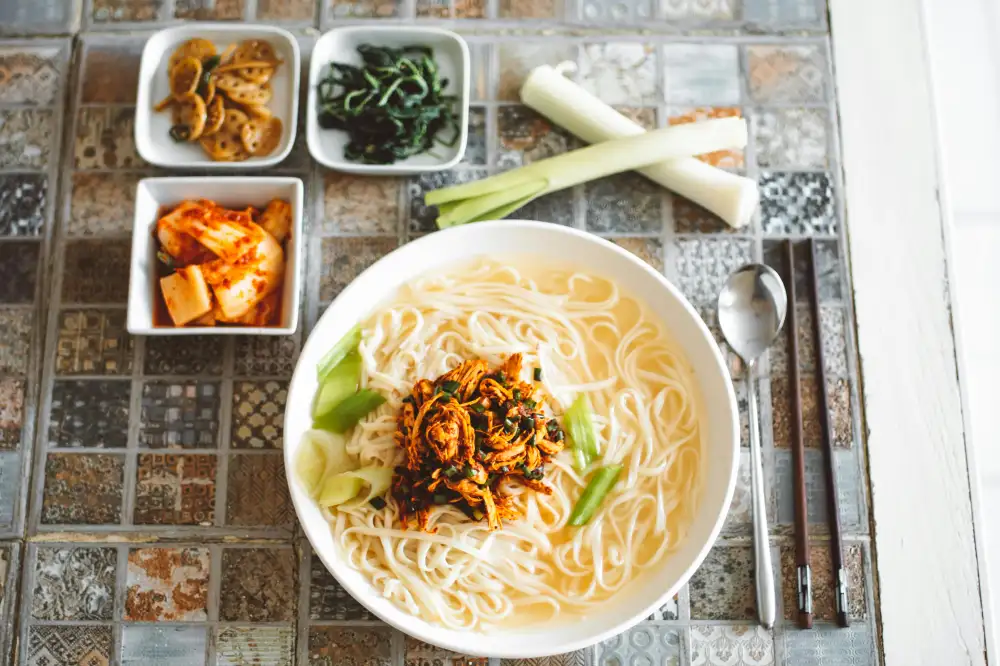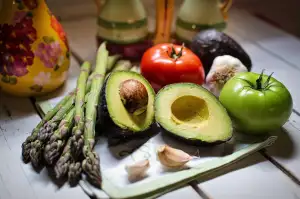Easy Kimchi Recipe: Uncover the Secrets to Making Delicious Kimchi at Home

- Understanding the Health Benefits of Kimchi
- Gathering the Ingredients for Easy Kimchi Recipe
- Step-by-Step Guide to Making Kimchi at Home
- 1 Preparing the Vegetables for Kimchi
- 2 Creating the Kimchi Paste
- 3 Fermenting and Storing Kimchi
- Tips and Tricks for Perfecting Your Kimchi
- Exploring Variations and Additions to Kimchi
- Serving Suggestions and Pairings for Kimchi
Kimchi, a traditional Korean dish, has gained popularity around the world for its unique flavors and health benefits. Made from fermented vegetables, such as cabbage and radishes, kimchi is known for its tangy and spicy taste. It is a staple in Korean cuisine and is often served as a side dish or used as an ingredient in various dishes. Kimchi is not only delicious but also packed with nutrients like vitamins A and C, fiber, and probiotics. Its fermentation process enhances its nutritional value and promotes gut health. In this article, we will uncover the secrets to making delicious kimchi at home, so you can enjoy this flavorful and nutritious dish anytime you want.
Understanding the Health Benefits of Kimchi
Kimchi, a traditional Korean dish made from fermented vegetables, is not only delicious but also packed with numerous health benefits. This spicy and tangy condiment is rich in vitamins A, B, and C, as well as minerals like calcium and iron. It is also a great source of dietary fiber, which aids digestion and promotes a healthy gut.
One of the key health benefits of kimchi lies in its probiotic content. During the fermentation process, beneficial bacteria such as Lactobacillus are produced. These probiotics help maintain a healthy balance of gut flora, improving digestion and boosting the immune system.
Kimchi is also known for its antioxidant properties. The red pepper flakes used in kimchi contain capsaicin, which has been shown to have anti-inflammatory effects and may help reduce the risk of chronic diseases such as heart disease and cancer.
Furthermore, kimchi contains garlic and ginger, both of which have their own set of health benefits. Garlic has antimicrobial properties that can help fight off infections, while ginger has anti-inflammatory properties that can aid in reducing inflammation in the body.
Overall, incorporating kimchi into your diet can provide you with a range of health benefits. From boosting your immune system to improving digestion and reducing inflammation, this flavorful condiment offers a tasty way to enhance your overall well-being.
Gathering the Ingredients for Easy Kimchi Recipe
Before embarking on your kimchi-making adventure, it's crucial to gather all the necessary ingredients. The foundation of any great kimchi lies in fresh and high-quality vegetables. Here are the key ingredients you'll need:
1. Napa Cabbage: Look for a firm and compact head of napa cabbage, preferably organic. It should have crisp leaves with no signs of wilting or discoloration.
2. Radishes: Daikon radishes are commonly used in kimchi. Choose radishes that are firm, smooth-skinned, and free from blemishes.
3. Carrots: Opt for bright orange carrots that are firm and free from soft spots or wrinkles.
4. Green Onions: Select green onions with crisp green tops and fresh-looking white bulbs.
5. Garlic: Fresh garlic cloves will provide the best flavor. Look for plump cloves with no signs of sprouting or mold.
6. Ginger: Choose ginger root that is firm, smooth-skinned, and free from wrinkles or mold.
7. Korean Red Pepper Flakes (Gochugaru): This is a crucial ingredient for authentic kimchi flavor. Look for gochugaru specifically made for kimchi, as it has the right level of spiciness and smokiness.
8. Fish Sauce: Traditional kimchi often includes fish sauce for added umami flavor. Ensure you choose a high-quality fish sauce without any additives or preservatives.
9. Sea Salt: Use sea salt without iodine or anti-caking agents, as these can interfere with the fermentation process.
10. Sugar: A small amount of sugar helps balance the flavors in kimchi.
By gathering these ingredients before you begin, you'll be well-prepared to create a delicious batch of homemade kimchi that will leave your taste buds craving more!
Step-by-Step Guide to Making Kimchi at Home
4.1 Preparing the Vegetables for Kimchi
To create delicious kimchi at home, it is essential to start with fresh and crisp vegetables. Traditionally, Napa cabbage is used as the main ingredient in kimchi. Begin by removing any wilted or damaged outer leaves from the cabbage head. Then, cut the cabbage in half lengthwise and remove the core.
Next, sprinkle salt between each leaf of the cabbage to help draw out excess moisture. This process not only seasons the cabbage but also ensures a crunchy texture in your final kimchi. Allow the salted cabbage to sit for about 2 hours, flipping it halfway through.
While waiting for the cabbage to sweat, prepare other vegetables such as radishes, carrots, and green onions. Julienne or thinly slice these vegetables according to your preference. These additional ingredients add vibrant colors and flavors to your kimchi.
After rinsing off the excess salt from the cabbage, gently squeeze out any remaining water. It's important not to rinse off all of the salt as it contributes to flavor development during fermentation. Now you're ready to move on to creating the flavorful kimchi paste that will bring your homemade kimchi to life!
2 Creating the Kimchi Paste
2. Creating the Kimchi Paste
The key to making delicious kimchi lies in creating a flavorful and well-balanced kimchi paste. This paste serves as the foundation for the unique taste and aroma of kimchi. Traditionally, it is made by combining various ingredients that contribute to its distinct flavor profile.
To create the kimchi paste, start by blending together garlic, ginger, and fish sauce or salted shrimp. These ingredients add depth and umami to the paste. Next, add Korean red pepper flakes (gochugaru), which provide the signature spiciness of kimchi.
To balance out the heat, incorporate a sweet element such as sugar or honey. This helps mellow down the spice while adding a touch of sweetness to the final product. Additionally, you can include a small amount of soy sauce for extra savory notes.
Mix all these ingredients thoroughly until they form a thick and vibrant red paste. The flavors should be well-integrated, with no single ingredient overpowering the others.
Remember that the proportion of each ingredient can be adjusted according to personal preference. Some prefer their kimchi spicier, while others may opt for a milder version. Experimentation is encouraged to find your perfect balance of flavors.
Once you have created your kimchi paste, it's time to move on to the next step: fermenting and storing your homemade kimchi.
3 Fermenting and Storing Kimchi
4.3 Fermenting and Storing Kimchi
Once you have prepared your kimchi, it's time to let the fermentation process work its magic. Place the kimchi in a glass jar or airtight container, ensuring that there is enough space at the top for expansion. Press down on the kimchi to remove any air bubbles and ensure that it is fully submerged in its own juices.
Now, you can choose how long you want to ferment your kimchi. For a milder flavor, let it ferment at room temperature for 1-2 days. If you prefer a stronger and more tangy taste, allow it to ferment for up to a week or even longer in the refrigerator.
During fermentation, gases will be released, so be sure to burp the container every day by opening it slightly to release any built-up pressure. This will prevent the container from exploding or leaking.
After the desired fermentation period, transfer your kimchi to the refrigerator for long-term storage. The cold temperature will slow down the fermentation process and help preserve its flavors. Properly stored kimchi can last for several months.
Remember that as kimchi ages, its flavors will continue to develop and intensify. So feel free to taste it periodically during storage and adjust seasoning if needed.
By following these steps, you'll be able to enjoy homemade kimchi that is bursting with flavor and packed with beneficial probiotics. So go ahead and embark on this delicious journey of fermenting and storing your very own batch of kimchi!
Tips and Tricks for Perfecting Your Kimchi
1. Use the right cabbage: Napa cabbage is the most commonly used cabbage for kimchi. Make sure to choose fresh, crisp heads of cabbage for the best results.
2. Salt your cabbage properly: Salting the cabbage helps to draw out excess moisture and adds flavor. Sprinkle salt evenly between the leaves and let it sit for about 2 hours before rinsing thoroughly.
3. Adjust spice levels to your preference: Kimchi can be as mild or as spicy as you like. Experiment with different amounts of gochugaru (Korean red pepper flakes) to find your desired level of heat.
4. Don't forget the fish sauce: A key ingredient in traditional kimchi, fish sauce adds depth and umami flavor. Use a good quality fish sauce for best results.
5. Give it time to ferment: Fermentation is what gives kimchi its distinct tangy flavor. Let your kimchi sit at room temperature for at least 24 hours before transferring it to the refrigerator.
6. Burp your jars: During fermentation, gases build up inside the jars. To prevent explosions, open the lids slightly every day to release excess gas.
7. Store properly: Once fermented, store your kimchi in airtight containers in the refrigerator to slow down further fermentation and maintain its freshness.
By following these tips, you'll be well on your way to perfecting your homemade kimchi and enjoying its delicious flavors!
Exploring Variations and Additions to Kimchi
While traditional kimchi is made with cabbage, there are numerous variations and additions that can be incorporated into this delicious dish. One popular variation is radish kimchi, known as "kkakdugi," which adds a crunchy texture and slightly sweet flavor to the mix. Another option is cucumber kimchi, or "oi-sobagi," which offers a refreshing and crisp taste.
For those who enjoy spice, adding chili peppers or chili flakes can enhance the heat level of the kimchi. Additionally, experimenting with different vegetables such as carrots, onions, or even fruits like apples or pears can introduce new flavors and textures to your homemade kimchi.
Some people also like to add seafood elements to their kimchi for an extra umami kick. This can include ingredients such as fish sauce, shrimp paste, or even small dried anchovies. These additions lend a unique depth of flavor to the kimchi and create a more complex taste profile.
Remember that when exploring variations and additions to kimchi, it's important to maintain the balance of flavors. Start by incorporating small amounts of additional ingredients and adjust according to personal preference. The beauty of making your own kimchi at home is that you have the freedom to experiment and tailor it to your liking.
By exploring these variations and additions, you can create a range of unique flavors that will keep your taste buds excited with every bite. So don't be afraid to get creative in the kitchen and let your imagination run wild when making your own homemade kimchi!
Serving Suggestions and Pairings for Kimchi
Kimchi is a versatile condiment that can enhance the flavors of various dishes. Here are some serving suggestions and pairings to enjoy your homemade kimchi:
1. Traditional Korean Meal: Serve kimchi as a side dish alongside steamed rice, grilled meat or fish, and other banchan (Korean side dishes). The spicy and tangy flavors of kimchi complement the savory main dishes perfectly.
2. Kimchi Fried Rice: Transform leftover rice into a delicious meal by stir-frying it with kimchi, vegetables, and protein of your choice. The fermented flavors of kimchi add depth to this simple yet satisfying dish.
3. Kimchi Pancakes: Make savory pancakes by mixing chopped kimchi with batter made from flour, eggs, and water. Fry them until golden brown for a crispy texture. Serve with soy dipping sauce for a delightful appetizer or snack.
4. Kimchi Soup/Stew: Add kimchi to soups or stews for an extra kick of flavor. The spiciness and acidity of kimchi can elevate the taste of any broth-based dish, such as tofu soup or spicy pork stew.
5. Sandwiches/Wraps: Use kimchi as a filling in sandwiches or wraps to add a zesty twist. It pairs well with grilled meats, cheese, or even avocado for a unique fusion flavor experience.
6. Noodle Dishes: Incorporate kimchi into noodle dishes like ramen or stir-fried noodles for added complexity and heat. The vibrant colors and bold flavors of kimchi make these dishes more exciting.
7. Salads/Bowls: Top your salads or grain bowls with kimchi to give them an extra burst of flavor. The crunchiness and tanginess of kimchi can liven up any salad combination.
8. Burgers/Tacos: Use kimchi as a topping for burgers or tacos to add a spicy and tangy element. It pairs well with grilled meats, cheese, and other condiments, creating a unique fusion of flavors.
Remember, kimchi is not limited to Korean cuisine alone. Feel free to experiment and incorporate it into your favorite dishes to discover new flavor combinations that suit your palate. Enjoy the versatility of homemade kimchi!
In conclusion, making your own kimchi at home is a rewarding and delicious endeavor. By following this easy kimchi recipe, you can unlock the secrets to creating a flavorful and healthy dish that will impress your family and friends.
Not only does kimchi offer a unique taste experience, but it also provides numerous health benefits. Its fermentation process enhances the nutritional value by increasing the levels of vitamins, minerals, and probiotics. Regular consumption of kimchi may contribute to improved digestion, boosted immunity, and reduced inflammation.
With just a few simple ingredients like cabbage, radishes, garlic, ginger, and chili flakes, you can create a homemade kimchi paste that is bursting with flavor. The step-by-step guide ensures that you achieve the perfect balance of tanginess and spiciness in your kimchi.
Remember to ferment your kimchi for at least a few days to allow the flavors to develop fully. Proper storage in an airtight container in the refrigerator will keep your kimchi fresh for several weeks.
To perfect your homemade kimchi, consider these tips and tricks: adjust the spice level to suit your taste preferences, experiment with different vegetables or fruits for added variety, and be patient during fermentation for optimal results.
Once you have mastered the art of making basic kimchi, feel free to explore variations and additions such as adding seafood or experimenting with different seasonings. The possibilities are endless!
When it comes to serving suggestions and pairings for kimchi, it is incredibly versatile. Enjoy it as a side dish with rice or noodles, use it as a topping on burgers or tacos for an extra kick of flavor, or incorporate it into stir-fries and soups.
In conclusion, making easy kimchi at home not only allows you to enjoy its incredible taste but also gives you control over its ingredients and fermentation process. So why not embark on this culinary adventure and experience the joy of creating your own homemade kimchi?
Published: 10. 02. 2024
Category: Recipes



